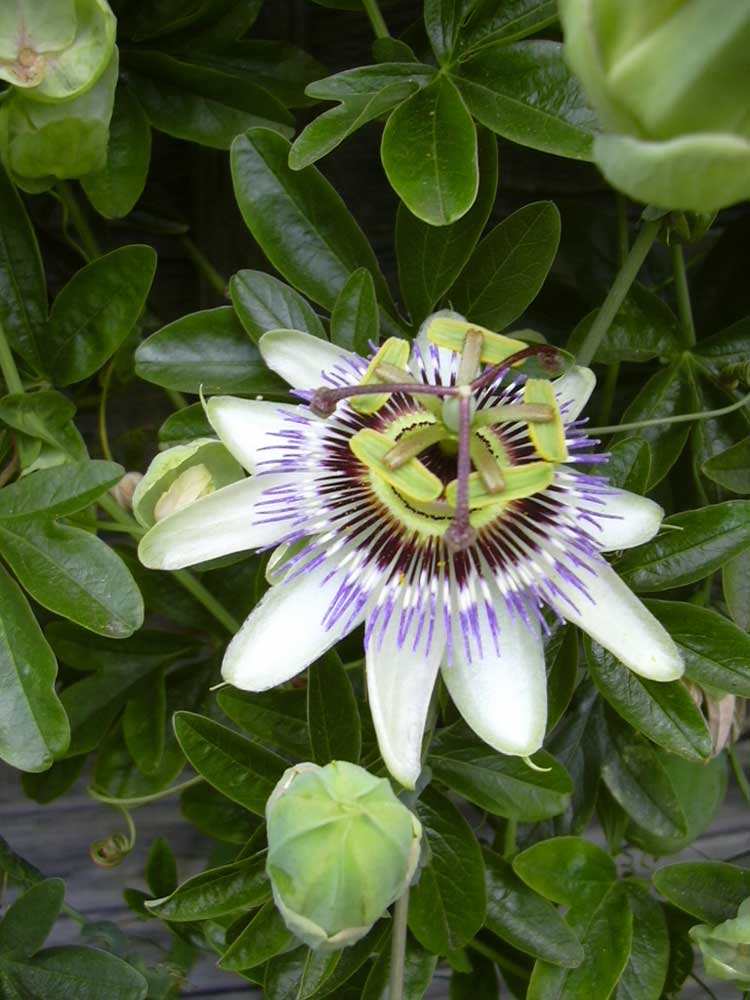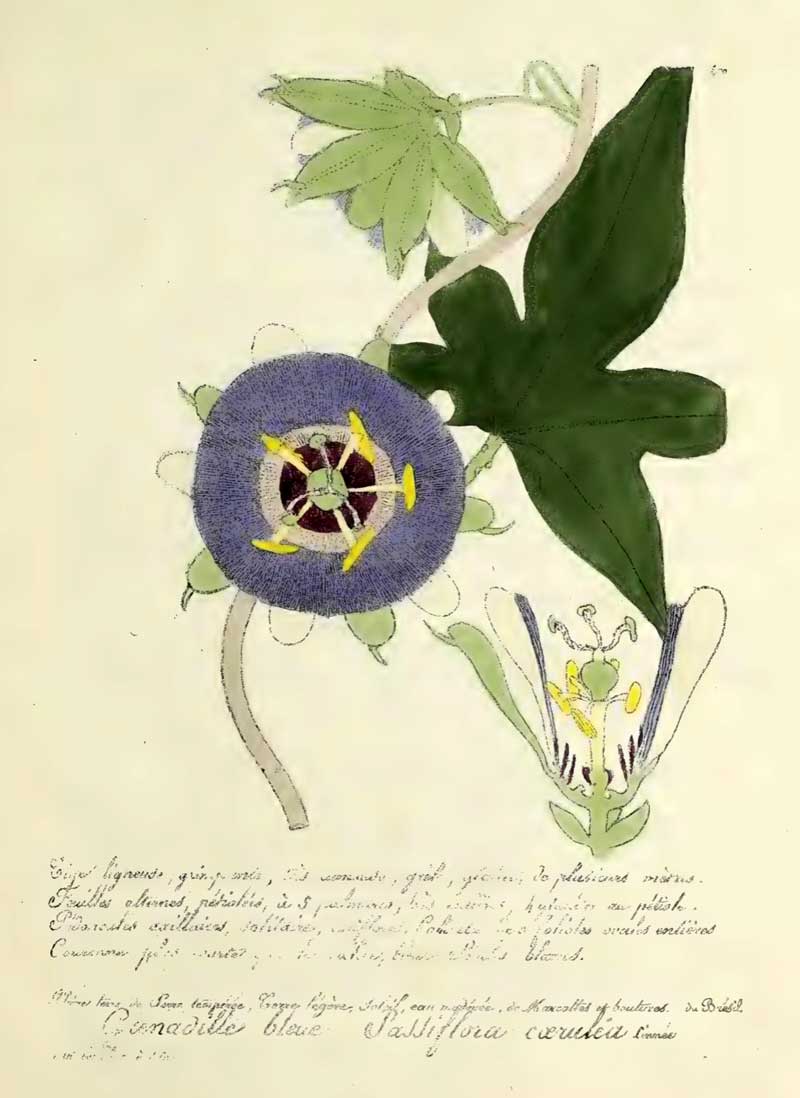
Passiflora caerulea (*)
Classification System: APG IV
Superregnum: Eukaryota
Regnum: Plantae
Cladus: Angiosperms
Cladus: Eudicots
Cladus: Core eudicots
Cladus: Rosids
Cladus: Eurosids I
Ordo: Malpighiales
Familia: Passifloraceae
Genus: Passiflora
Subgenus: P. subg. Passiflora
Supersectio: P. supersect. Stipulata
Sectio: P. sect. Granadillastrum
Species: Passiflora caerulea
Name
Passiflora caerulea L.
Typus: Brasil: Minas Gerais, Caldas (Pedra Branca), Regnell III 636, s/data (K).
Synonyms
Homotypic
Delocaba caerulea (Lam.) (1783)
Granadilla caerulea (L.) Medik., Malv. 96 (1787).
Passiflora caerulea Lour. ex DC., Prodr. (Candolle) 3: 330 (1828).
Heterotypic
Passiflora caerulea var. angustifolia G.Don, Gen. Hist. 3: 53 (1834).
Passiflora caerulea var. glauca Mast., Fl. Bras. (Martius) 13, pt. 1: 617 (1872).
Passiflora caerulea var. glaucophylla G.Don, Hist. pl. Dichl. 3: 53 (1834).
Passiflora caerulea var. imbricata Mast., Fl. Bras. (Martius) 13, pt. 1: 617 (1872).
Passiflora caerulea var. regnellii Mast., Fl. Bras. (Martius) 13(1): 617 (1872).
Passiflora loureiroi G.Don, Gen. Hist. 3: 54 (1834).
Passiflora selloi Dehnh., Revist. Napol. 1(3): 180 (1840).
Hybrids
Passiflora × allardii Lynch
Passiflora × colvillii Sw.
Passiflora × kewensis Nicholson
Passiflora × violacea Loisel.

References
Linnaeus, C. 1753. Species Plantarum. Tomus II: 959. Reference page.
Tropicos.org 2009. Passiflora caerulea. Missouri Botanical Garden. Published online. Accessed: 16 Feb 2009.
Vernacular names
العربية: الساعة (نبات)
български: Синя пасифлора
bosanski: Pasijonka
català: Passionera
dansk: Blaa passionsblomst
Deutsch: Blaue Passionsblume
English: Blue Passion Flower
español: Flor de la pasión
فارسی: پیچ ساعتی گل آبی رنگ
suomi: Kärsimyspassio
Avañe'ẽ: Mburukuja
עברית: שעונית כחולה
hornjoserbsce: Módra ćerpjenka
magyar: Kék golgotavirág
italiano: Passiflora azzurra
日本語: トケイソウ
한국어: 시계꽃
नेपाली: घडीफूल
Nederlands: Blauwe passiebloem
polski: Męczennica błękitna
português: Maracujá azul
русский: Страстоцвет голубой
svenska: Blå passionsblomma
Tiếng Việt: Lạc tiên cảnh
中文: 西番莲,百香果
Passiflora caerulea, the blue passionflower,[1] bluecrown passionflower[2] or common passion flower, is a species of flowering plant native to South America. It has been introduced elsewhere. It is a vigorous, deciduous or semi-evergreen tendril vine growing to 10 m (33 ft) or more. Its leaves are palmate, and its fragrant flowers are blue-white with a prominent fringe of coronal filaments in bands of blue, white, and brown. The ovoid orange fruit, growing to 6 cm (2 in), is edible but bland.[3]
Names
The specific epithet caerulea means "blue" and refers to the blue coronal filaments.[4]
Description
Photograph of P. caerulea.
Passiflora caerulea is a woody vine capable of growing to 25 metres (82 ft) high where supporting trees are available.[5] The leaves are alternate, palmately five-lobed (sometimes three, seven, or nine lobes), and are up to 10 centimetres (3.9 in) in length while being linear-oblong shaped.[6] The base of each leaf has a flagellate-twining tendril 5–10 centimetres (2.0–3.9 in) long, which twines around supporting vegetation to hold the plant up.[5]
The flower is complex, about 10 centimetres (3.9 in) in diameter,[6] with the five sepals and petals similar in appearance, whitish in colour, surmounted by a corona of blue or violet filaments, then five greenish-yellow stamens and three purple stigmas.[5] The fruit is an oval orange-yellow berry, 6 centimetres (2.4 in) long by 4 centimetres (1.6 in) in diameter, containing numerous seeds.[5] It is edible to humans when ripe, but tends to have an undesirable flavour.[7]
Cultivation
Passiflora caerulea is widely cultivated as a wall-climber or as groundcover. Though hardy down to −10 °C (14 °F), it requires a sheltered position facing south or west (in the Northern Hemisphere). It can become invasive, the twining shoots constantly appearing unless eradicated. It has gained the Royal Horticultural Society's Award of Garden Merit.[8]
Cultivars
White flowered ‘Constance Elliott’
A number of cultivars have been produced from the species:-
'Chinensis' (corona filaments paler blue)
'Constance Elliott' was raised by Kucombe and Prince in Exeter, Great Britain. It has pure white, fragrant flowers; not as free-flowering as many other clones. It has also won the Award of Garden Merit[9]
'Pierre Pomie', a pale pink flower form
Chemical constituents
Compared to Passiflora incarnata, this plant contains higher amounts of the MAO-inhibitor harmine.[10]
Other uses
Passiflora caerulea and fruit
Though the fruit is edible, it is rather insipid when eaten raw. A tea can be made of the flower or leaves; however, tetraphyllin B and epi-tetraphyllin B, cyanogenic glycosides which liberate hydrogen cyanide when activated by enzymes, have been found in the leaves. It is possible to boil away most of the cyanide.[11]
The passion flower is the national flower of Paraguay. Its intricate structure has generated Christian symbolism, each part representing a different part of the Passion of Christ. The "Etymology and names" section of Passiflora contains more information about this symbolism.
References
BSBI List 2007 (xls). Botanical Society of Britain and Ireland. Archived from the original (xls) on 2015-06-26. Retrieved 2014-10-17.
USDA, NRCS (n.d.). "Passiflora caerulea". The PLANTS Database (plants.usda.gov). Greensboro, North Carolina: National Plant Data Team. Retrieved 31 January 2016.
RHS A-Z encyclopedia of garden plants. United c ZKingdom: Dorling Kindersley. 2008. p. 1136. ISBN 978-1405332 965.
Harrison, Lorraine (2012). RHS Latin for gardeners. United Kingdom: Mitchell Beazley. p. 224. ISBN 9781845337315.
"Factsheet - Passiflora caerulea (Blue Passionflower)". keys.lucidcentral.org. Retrieved 14 August 2018.
"Passiflora caerulea: info from PIER (PIER species info)". www.hear.org. Pacific Island Ecosystems at Risk project (PIER). Retrieved 14 August 2018.
Popay, Ian. "Passiflora caerulea (blue passionflower)". www.cabi.org. Retrieved 14 August 2018.
"RHS Plant Selector - Passiflora caerulea". Archived from the original on 7 August 2013. Retrieved 25 May 2013.
"RHS Plantfinder - Passiflora caerulea 'Constance Elliott'". Retrieved 18 April 2018.
Frye, Abigail; Haustein, Catherine (2007). "Extraction, Identification, and Quantification of Harmala Alkaloids in Three Species of Passiflora". American Journal of Undergraduate Research. 6 (3). doi:10.33697/ajur.2007.020.
DS Seiglera, KC Spencera, WS Statlerb, EE Connb, JE Dunnb, 'Tetraphyllin B and epitetraphyillin B sulphates: Novel cyanogenic glucosides from Passiflora caerulea and P. alato-caerulea', Phytochemistry, 21/9 (1982), 2277-2285.
Retrieved from "http://en.wikipedia.org/"
All text is available under the terms of the GNU Free Documentation License

